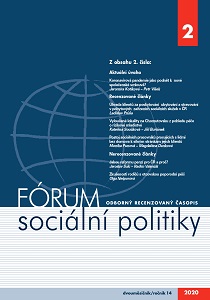Vyloučené lokality na Chomutovsku z pohledu péče o rizikové mladistvé
Excluded localities in the Chomutov region from the perspective of the social and legal protection of young persons
Author(s): Kateřina Součková, Jiří BuriánekSubject(s): Economic policy, Welfare systems, Applied Sociology, Criminology, Family and social welfare, Present Times (2010 - today), Penal Policy
Published by: Výzkumný ústav práce a sociálních věcí
Keywords: juvenile delinquency; department for the social and legal protection of young persons; family; social exclusion; cluster analysis;
Summary/Abstract: The paper focuses on the comparison of excluded localities in the Chomutov region from the perspective of clients of the department for the social and legal protection of young persons (OSPOD) based on the analysis of records compiled by department personnel on children and young persons in 2017 (concerning 510 registered clients) with respect to educational problems, the family situation and delinquent behaviour. Exploratory cluster analysis served to prove the functionality of the existing classification of locations with regard to the extent and risk of the clientele. Although the relationship between the risk inherent in the location and the extent of delinquency and educational problems was confirmed, the excluded housing estates were not found to differ significantly from other excluded localities (including the city centre). Conversely, the areas near to such housing estates formed part of a group of less risk-inherent locations in the city. Interestingly, the excluded housing estates were found to have a higher proportion of girls in the clientele, and the poor social situation of the family (a dependence on social benefits) was determined as exerting a strong influence on the rate of delinquency. While risk-inherent locations do not constitute particular worlds characterised by specific delinquent tendency mechanisms, such mechanisms are reinforced by a state of disorganisation that, in addition to the social deprivation of the family and the disorderly character of the immediate vicinity, appear to weaken the community- 's ability to respond effectively. While OSPOD clientele thus represent a specific sample characterised by problems in a "condensed" form, at the same time they express the more general characteristics of the environment under investigation. From the social policy point of view, particular attention should be devoted to what might be described as a looming triangle of poverty − educational problems − school (with an emphasis on the potential of schools with respect to supporting families and pupil involvement).
Journal: Fórum sociální politiky
- Issue Year: 2020
- Issue No: 2
- Page Range: 10-18
- Page Count: 9
- Language: Czech

